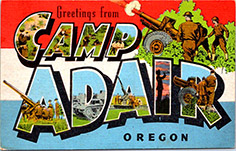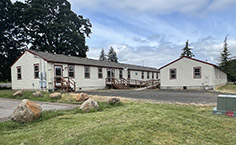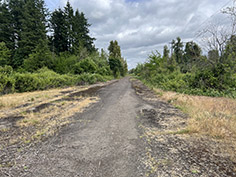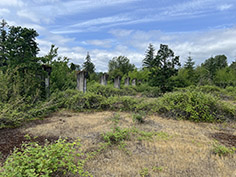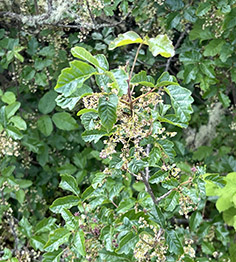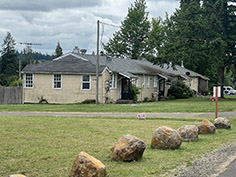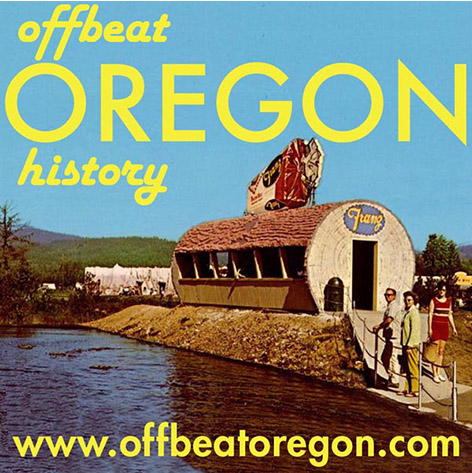CONTINUED FROM THE PRINT EDITION:
Oregon’s second-largest city was built in 6 months
As for the Timberwolves, they at least were spared from the disappointment — their training started in the middle of winter that same year. “Basic training for the newly arrived recruits (of the 104th Infantry) started on Dec. 14, 1942,” wrote Leo Hoegh and Howard Doyle of the 104th, in a 1946 article in the Washington Infantry Journal Press. “The soldiers soon learned why the natives along the Willamette Valley hibernated each winter. Raincoats were part of the regular uniforms as the dougboys sloshed along over the sodden countryside and learned to throw themselves in the cold mud with disregard. “During ‘Basic,’ men could be seen marching in every direction and in every formation. They were learning to become fighting soldiers. As motorists rode on Highway 99W past the cantonment, they saw some of the grimmest training that American soldiers could get. Cold steel flashed in the sunlight or pierced the fog. Whatever the weather, the infantrymen were attacking dummies with the bayonet. All the men learned their weapons and in January they were firing record courses in the driving rain and blinding snow.” Of course, from the Army’s standpoint, the relentless awfulness of the weather and terrain was a feature, rather than a bug. As the soldiers learned to survive and fight through the harsh conditions of a Willamette Valley winter, they developed the toughness that would enable them to survive under similar conditions when German or Japanese soldiers were shooting at them. That didn’t make it any more fun, though, for the men who were being thus toughened. Later the 30th “Powder River” and 70th “Trailblazers” infantry divisions joined the 96th and 106th, so that if misery really did love company, there was at least the comfort of more company for the miserable, cold, muddy, itchy soldiers. “After a week in the rain and cold, by the weekend the barracks were a luxury, as was a weekend pass in any of the surrounding towns,” historian Baker writes. “When any Camp Adair soldier was asked about training at the camp, even though he might have said how beautiful the Willamette Valley was, he usually replied, ‘wet, cold, rain-soaked, hot, itchy, and full of poison oak.’ ” Poison oak was a particular hazard for soldiers at Camp Adair. The climate and environment throughout the 60,000 acre campus was nearly ideal for the stuff, and soldiers quickly learned to recognize it with dread. Severe poison-oak rashes became one of the most common ailments treated in the camp hospital. As the war dragged on, too, it got harder to visit those neighboring towns, as cars and car parts were not available (especially tires). By the time the war ended, though, Camp Adair was no longer being used to train soldiers. As the rush of recruits early in the war abated, the Army found it was easier to train the remaining troops in camps closer to the major population centers. So Camp Adair became a prisoner-of-war camp for the last few months of the war. The camp hospital, too, stayed busy for the duration. But by the end of the war, Camp Adair was largely unused. And as the Army looked around at all the surplus war materiel that it had created to fight the great struggle, Camp Adair was probably pretty close to the top of everyone’s list of places that could be easily closed down to save money.
|
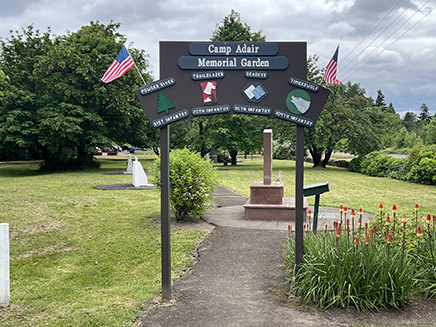
III. Closure.MOST OF CAMP Adair was torn down almost as quickly as it had been put up. The main cantonment buildings were declared surplus at the end of 1945, and various salvage contractors were invited to come dismantle it for resale. Dozens, possibly hundreds, of Camp Adair houses were sold off to homebuilders around the valley. At least some of those were sold in 8-by-12 or 8-by-16-foot panels — the walls of the buildings were made of one-inch tongue-and-groove boards ribbon-nailed to cross braces of the same stock and with 3/8-inch sheet-rock (Kaiser brand) secured to the inside, an approach that has been dubbed “structural sheathing.” If you are looking at a modest house in the Willamette Valley with two-inch-thick walls, chances are good that you’re looking at a Camp Adair house. The hospital section was turned over to Oregon State University, and it was used for some years after the war as housing for students studying at the college on the G.I. bill — of whom there were quite a few, of course, freshly returned from the war. They called it Adair Student Village. It was closed and most of the apartment buildings demolished in 1951, but by that time a town had sprung up around it, and that town today is of course Adair Village. Large parts of the wooded southwestern area of the campus, including the old townsite of Tampico and a large swath of Soap Creek Valley, were handed over to OSU and added to its Dunn Forest holdings. Visitors to those lands still today occasionally find “souvenirs” from the days when maneuvers and live-fire training was done there. (I myself found a coil of razor wire there during a Benton County Search and Rescue training exercise on Prune Ridge in 2004, and another member of our party found an old expended smoke grenade.) In 1957, part of the cantonment area became Adair Air Force Station and SAGE Support Facility — SAGE was a system of information processing computers and equipment linked to the nation’s radar and other sensors during the Cold War, which was built for purposes of detecting a Soviet attack in time to respond. Plans were made to install a battery of surface-to-air missiles on the site. But, before that work could get started, the program was canceled, and the Air Force closed down its facilities there in 1969. Today, the northeastern corner of Camp Adair is a wildlife refuge, the E.E. Wilson. It’s been restored to the seasonal wetland that it once was, so mosquitos are not unknown there, although — thanks to the plentiful bug-eating wildlife — not as common as you might expect. The long, straight, broad stretches of abandoned blacktop make for a pleasant bicycling spot, and the plentiful ruins and foundation walls are great for geocaching. It’s an especially rewarding place to visit with a copy of Baker’s book to use as a “ghost town guide.” In the town of Adair Village today, a few of the older houses as well as businesses are still housed in old Camp Adair houses — either adopted as they stood, or purchased from a salvage company and moved to the site. Along William R. Carr Avenue, you can see two of the old barracks buildings that were purchased in 2010 for the Camp Adair Interpretive Center.
|

